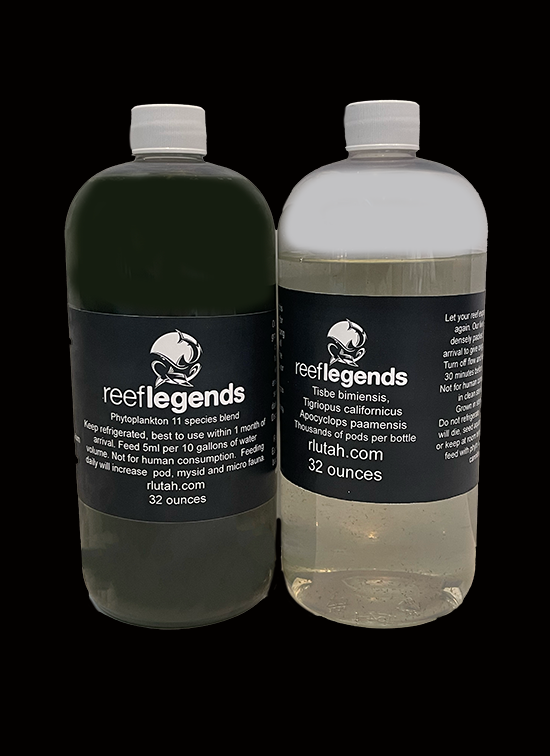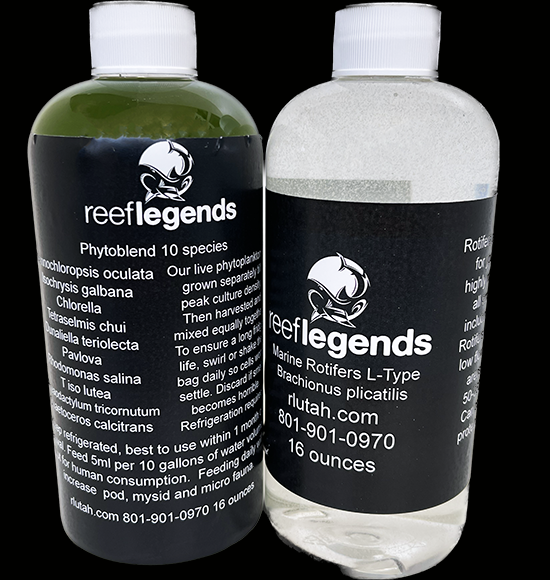The best way to seed an aquarium or refuel your copepod population. Get 3 of the most common marine copepods in one bottle to help your reef aquaria take off again. We do recommend feeding live phytoplankton to your aquaria 2-4 times a week to help your copepods reproduce.
Our in house blend of single phytoplankton cultures combined at peak concentrations and never diluted. This blend has everything you could ask for! Contains the following phytoplanktons:
Green phytoplanktons (Nannochloropsis oculata,Tetraselmis chui, Chlorella, Dunaliella tertiolecta)
Golden phytoplanktons (Tisochrysis lutea, Pavlova, Isochrysis galbana)
Red phytoplankton (Rhodomonas salina, Porphyridium cruentum)
Orange phytoplankton (Chaetocerors calcitrans)
Brown phytoplanktons (Pheaodactylum tricornutum)
Yellow/Brown Phytoplankton (Thalassiosira weissfloggii)
This is an exceptional mix of phytoplanktons that will make your corals feel like they are back in the ocean. Feeding this blend will help reduce nitrates, phosphate and silicates in your water column while providing the essential building blocks most corals feed on naturally. Rhodomonas is the essential building block to add more color to your corals, a strain that you that's hard to come by. Refrigeration required on both bottles. Rotifers last 3 weeks refrigerated. Phytoplankton lasts 1 month refrigerated.
The best way to check the density on the bottle you receive is by shining a light into the bottle to see the rotifers. They are hard to see in the bottle without shining a light.
Tigriopus californicus will take 3-4 weeks before you start noticing a dramatic increase in population. If you are going to grow them we recommend waiting 5-6 weeks after receiving them and feeding them regularly before your first harvest, by this time your Tigriopus population should be doubled to tripled then harvesting every 2 weeks after that. Tigriopus californicus are loaded with omega-3 fatty acids making them ideal for picky eaters such as butterflies or mandarin gobys. These pods are known for their jerking motion that encourages fish to feed upon them. Females will lay hundreds of eggs during their lifecycle, if you use your phone to zoom in or a microscope you'll see females carrying eggs.
Tisbe copepods are small copepods that require a light to be shown at the bottom of the bottle to see them. We send all sizes/ages in each bottle. Tisbe copepods are a moderate production copepod, needing 2-3 weeks before harvesting. Tisbe pods will consume large amounts of phytoplankton while culturing, you'll often notice you'll have to feed them 4-5 times a week once your population takes off. They also make for a great clean up crew in your reef aquarium, they are bottom dwellers and love to hide in the rocks making them hard for small to medium fish to eat. (mandarins gobys love hunting these guys down) Tisbe copepods are loaded with high nutritional content when fed live phytoplankton.
Apocyclops copepods are medium size, slightly larger than tisbe and slightly smaller than Tigriopus copepods. Youll see these guys jerking in the water column, enticing smaller fish to eat. Apocyclops females will lay eggs every 4-6 days, meaning you can harvest them on a weekly basis if you're culturing them.











